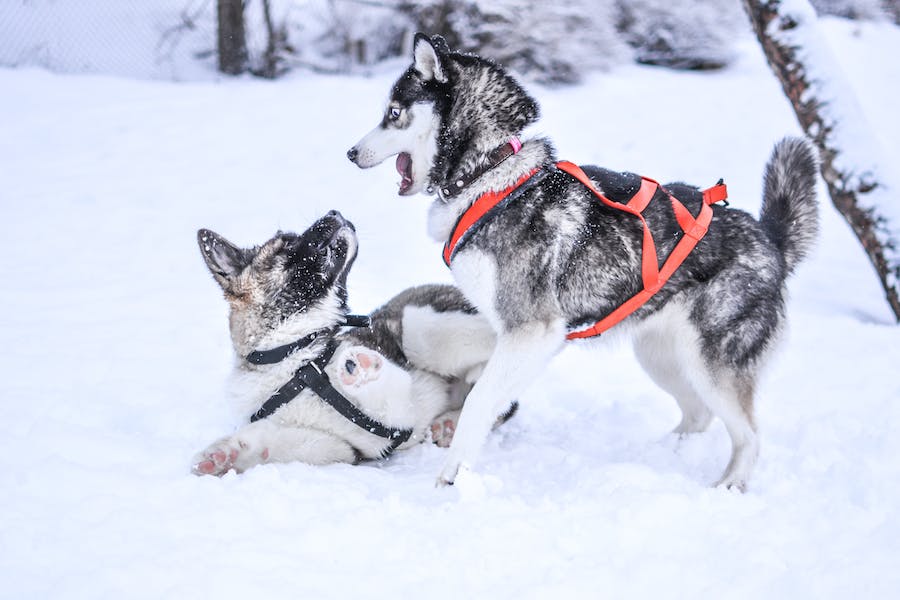Huskies, renowned for their striking appearance and vibrant energy, are a breed that captivates the hearts of dog lovers worldwide. Originating from the Siberian Arctic, these intelligent and independent dogs are known for their friendly nature and distinctive vocalizations. Training a Husky is a unique challenge, demanding an understanding their needs and characteristics. This article delves into the essentials of Husky training, offering practical advice and insights to help you develop a robust and healthy relationship with your Husky. From mastering basic commands to addressing breed-specific behaviors, we’ll guide you through training your Husky, ensuring you and your furry companion enjoy a harmonious and fulfilling life together.
How To Train A Husky?
Training a Husky requires patience, consistency, and an understanding of their unique characteristics. Here’s a detailed approach:
Start Early and Establish Leadership:
Train your Husky when you bring them home. Huskies respect strong leadership. Establish yourself as the pack leader by setting rules and boundaries. Use positive reinforcement to encourage good behavior.
Consistency is Key:
Huskies thrive on routine and consistency. Stick to a regular training schedule and follow your commands and rules. This helps them understand what is expected of them.
Socialization:
Huskies are social creatures and need to be well-socialized. Expose them to different people, animals, environments, and situations from a young age. This helps prevent behavioral issues like aggression and fearfulness.
Obedience Training:
Focus on basic obedience commands such as ‘sit’, ‘stay’, ‘come’, and ‘heel.’ Huskies can be stubborn, so be patient. Use treats and praises as rewards. Keep training sessions short and fun to maintain their interest.
Exercise and Mental Stimulation:
Huskies are high-energy dogs and require plenty of exercise. Ensure they get enough physical activity daily. Mental stimulation is equally important. Use games, puzzles, and training exercises to keep their mind engaged.
Dealing with Stubbornness:
Refrain from resorting to harsh methods if your Husky is stubborn. Instead, be firm and patient. Use positive reinforcement techniques like treats and praises to motivate them.
Leash Training:
Huskies are known to pull on the leash. Train them to walk beside you without pulling. Start in a quiet environment and gradually move to more distracting settings as they improve.
Behavioral Training:
Address common Husky behaviors like digging, howling, and chewing. Understand the root cause (like boredom or excess energy) and address it through more exercise or mental stimulation.
What Should You Know To Understand Your Husky Better?
Understanding your Husky better involves recognizing their unique physical and behavioral traits and their specific needs. Here are vital aspects to consider:
- Breed History and Purpose: Knowing that Huskies were originally bred as sled dogs in Siberia helps explain their high energy, endurance, and thick coat. This background influences their behavior and exercise requirements.
- Physical Characteristics: Recognize the distinct features of Huskies, such as their dense double coat, erect triangular ears, and striking eyes (which can be blue, brown, or heterochromatic). Their physical attributes dictate their grooming and climate adaptability needs.
- Energy Levels and Exercise Needs: Huskies are high-energy dogs. They require substantial daily exercise to maintain their health and happiness. Without enough physical activity, they can become restless and develop destructive behaviors.
- Intelligence and Independence: Huskies are intelligent but also known for their independent and sometimes stubborn nature. This affects how they respond to training and interact with their owners.
- Sociable Temperament: Huskies are generally friendly and pleasant with humans and other dogs. However, their sociability means they often don’t like being left alone for long periods, which can lead to separation anxiety.
What Are The Basic Training Commands For Huskies?
As with most dog breeds, the basic training commands for Huskies are crucial for establishing good behavior and effective communication between the dog and its owner. Here are some fundamental commands:
Sit: This command helps in instilling discipline and control. Train your Husky to sit by holding a treat above their nose and moving your hand up, causing them to sit naturally. Once they’re sitting, say “Sit,” give them the treat, and praise them.
Stay: This command is essential for safety and control, especially in public places. Start by asking your Husky to sit, then open your palm in front of you, say “Stay,” and take a few steps back. Reward them for staying put, gradually increasing the distance and duration.
Come: This recall command is vital for preventing dangerous situations. Begin in a distraction-free environment. Call your Husky’s name and “Come” in a cheerful tone. When they come to you, reward them with treats and affection. Practice this command often, gradually increasing distractions and distance.
Heel: This teaches your Husky to walk beside you rather than pulling on the leash. Start with your Husky on a leash beside you. Say “Heel” and walk forward. If they stay beside you, reward them. Stop and call them back to your side if they pull or lag.
Down: This command helps calm and control your dog in various situations. Hold a treat close to your Husky’s nose, then move your hand down to the ground, leading them into a lying position. Once they’re down, say “Down,” give them the treat, and praise them.
Leave it/Drop it: These commands are crucial for preventing your Husky from picking up or chewing on dangerous items. Teach “Leave it” by holding a treat in your closed hand. When your Husky stops trying to get it and moves away, say, “Leave it,” open your hand and give them the treat. For “Drop it,” offer a treat in exchange for whatever they have in their mouth, and say “Drop it” when they release the item.
How Can Socialization And Behavior Training Be Effectively Implemented For Huskies?
Effectively implementing socialization and behavior training for Huskies involves a combination of exposure, positive reinforcement, and understanding of their unique temperament. Here’s how you can approach it:
Begin socializing with your Husky at a young age. Puppies have a critical socialization period, typically up to about 14-16 weeks of age, during which they are most receptive to new experiences.
Gradually introduce your Husky to different people, environments, sounds, and other animals. This includes children, other dogs, household noises, and different settings like parks, busy streets, and quiet areas.
Reward your Husky with treats, praise, or playtime when they react positively or remain calm in various social situations. This helps them associate new experiences with positive outcomes.
These settings offer controlled environments where your Husky can interact with other dogs and people. Monitor their interactions and intervene if play becomes too rough or if your Husky becomes overwhelmed.
If your Husky exhibits unwanted behaviors like jumping, excessive barking, or aggression, address these immediately. Use redirection techniques, like diverting their attention to a toy or a different activity, and reinforce desired behaviors.
Huskies are high-energy dogs and require ample exercise. Regular physical activity helps reduce hyperactive and destructive behavior, making them more receptive to training.
Huskies can be independent and strong-willed, so patience and consistency in your training approach are crucial. Avoid negative reinforcement or punishment, which can lead to fear or aggression.
Bottom Line
Training a Husky requires a patient and consistent approach acknowledging their unique characteristics. Start early, establish yourself as the leader, and focus on basic commands like ‘sit,’ ‘stay,’ and ‘come.’ Socialization, regular exercise, and positive reinforcement are critical. Recognize their independent nature and be prepared for occasional stubbornness. Seek professional help, and always maintain a loving and understanding relationship with your Husky. You can successfully train and enjoy a harmonious life with your spirited Husky companion with time and dedication.
FAQ’s
Q. How do you discipline a Husky?
A: Discipline a Husky with positive reinforcement. Use rewards for good behavior, not punishment for evil. Consistent training, clear commands, and patience are key. Huskies respond best to rewards like treats, praise, and play. Avoid harsh methods, as they can lead to stubbornness or fear.
Q. Are Huskies difficult to own?
A: Huskies can be challenging to own due to their high energy levels, independence, and specific needs. They require regular exercise, mental stimulation, and socialization. Training can be challenging, but with patience and consistency, they make loyal and loving companions for those willing to invest time and effort in their care.
Q. What to do if a Husky is aggressive?
A: If a Husky shows signs of aggression, seek professional help from a certified dog behaviorist or trainer experienced with the breed. Avoid punishment, which can escalate aggression. Ensure their environment is safe, and keep them away from potential triggers. Prioritize their safety and the safety of others while addressing the underlying causes of aggression.







Leave a Reply